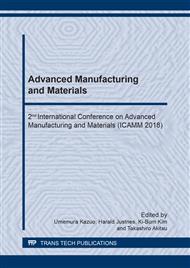[1]
Gao X Q, Ma Q F. New development of disc brakes for oil drilling rigs [J]. Oil Field Equipment, 2006, 35 (3): 92-94.
Google Scholar
[2]
Feng D, Tang H X, Zhou K et al. Status and Development Trend of Module Drilling Rig [J]. China Petroleum Machinery, 2008, 36 (9): 143-147.
Google Scholar
[3]
Shi J, Wu P Luo K. Study on Current Situation and Development Trend of Oil Drilling Technology in China [J]. Technology development, 2012 (8): 161-162.
Google Scholar
[4]
Zhang Y. Study on Current Situation and Development Trend of Oil Drilling Technology in China [J]. Henan Science and Technology, 2013 (21): 25-25.
Google Scholar
[5]
Wang X H, Zhang S W. Study on Friction and Wear Properties of Disc Brake Material for Oil Drilling Rig [J]. Lubrication Engineering, 2007, 32 (12): 5-8.
Google Scholar
[6]
Qu X W, Wang X P. Automobile brake without asbestos material [j]. China Plastics, 1997, 11 (2): 19-22.
Google Scholar
[7]
Liu Z Y, Huang B Y, Su D et al. Study on Research on Reinforced Fiber of Automotive Friction Materials [J]. Automobile Technology, 1999 (1): 19-22.
Google Scholar
[8]
Xie R H, Ding Z Y,Sheng H P et al. Effects of several modified phenolic resins on the performance of petroleum asphalt carbon fiber friction composites [J]. China Petroleum Processing Petrochemical Technology, 1999 (1): 30-32.
Google Scholar
[9]
Guan Q F, Li G Y,Li X N et al. Effects of Carbon Fiber on Friction and Wear Properties of Reinforced Friction Materials [J]. Natural Science Journal of Jilin University of Technology, 1997 (3): 73-77.
Google Scholar
[10]
Yuan G Z, Peng J X, Yao P B. Effects of boron content and particle size on properties of iron-copper-based friction materials [J]. Non-metallic minerals, 2001, 21 (2): 89-91.
Google Scholar
[11]
Yi T H. Research progress of high performance phenolic resin modification [J]. Chem Ind Eng Prog, 2001 (9): 13-16.
Google Scholar
[12]
Zneg Z B, Cao X K. Study on Properties of Modified Resin in Friction Materials [J]. Non-metallic Minerals, 1999 (6): 47-48.
Google Scholar
[13]
YinG C. Development of new non-asbestos brake material [J]. Insulating Materials 1999 (5): 31-32.
Google Scholar
[14]
Zhang Y S, Lou H L. Experimental Study on Allowable Temperature of Asbestos Friction Material / Steel Friction Pair [J]. Lubrication Engineering, 2000 (5): 19-21.
Google Scholar
[15]
Zhou Y. Technologic Research on Non-asbestos Disc Brake Block for Drilling Rig [J]. Non-Metallic Mines, 2010, 33(2):73-75.
Google Scholar
[16]
Zhou Y G, Shi Z G. Study on the technology of asbestos free disc brake block for drilling machine [J]. Non-metallic minerals, 2010, 33 (2): 73-75.
Google Scholar
[17]
Aleksendrić D. Neural network prediction of brake friction materials wear [J]. Wear, 2010, 268(1):117-125.
DOI: 10.1016/j.wear.2009.07.006
Google Scholar
[18]
Wang X H, Wang S W Wang D G. Wear mechanism of disc-brake block material for new type of drilling rig [J]. Frontiers of Mechanical Engineering in China, 2008, 3(1):10-16.
DOI: 10.1007/s11465-008-0009-2
Google Scholar


